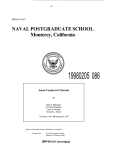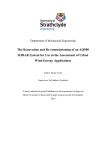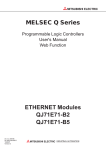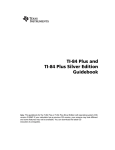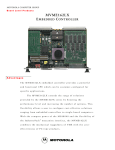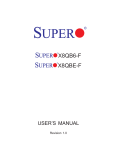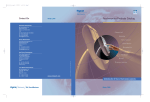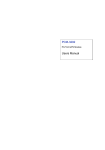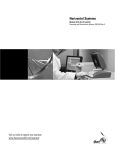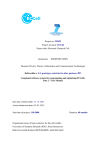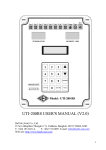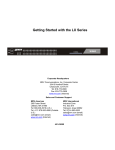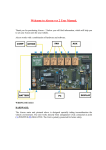Download Mini sodar manual
Transcript
Doppler miniSoDAR System Operation and Maintenance Manual July 2008 Atmospheric Systems Corporation 24900 Anza Dr., Unit D Valencia, CA 91355 Tel: +1.661.294.9621 Fax: +1.661.294.9667 e-mail: [email protected] Copyright © Atmospheric Systems Corp. 1999-2008 IMPORTANT This manual may not be reproduced in any manner (photocopy, facsimile, electronic copy or any other manner) without the expressed written consent of Atmospheric Systems Corporation. Written consent for reproduction of this manual must be obtained from: Atmospheric Systems Corporation 24900 Anza Dr., Unit D Santa Clarita, CA 91355 +1.661.294.9621 (office) +1.661.294.9667 (fax) [email protected] Copyright © Atmospheric Systems Corp. 1999 - 2008 -2- PRODUCT LIMITED WARRANTY STATEMENT Products manufactured by Atmospheric Systems Corporation (ASC) are warranted to the original user to be free of defects in material and workmanship for a period of 12 months from date of installation, but not more than 18 months from date of shipment from ASC’s facility, if installed, operated and maintained according to ASC’s product manual. ASC's liability under this warranty shall be limited to repairing or replacing defective material, at ASC's option, F.O.B. ASC's factory or authorized service station. ASC will not be liable for any costs of removal, installation, transportation, or any other charges, which may arise in connection with a warranty claim. This warranty shall be voided by damage or wear to products caused by abnormal operating conditions, accident, abuse, misuse, unauthorized alteration or repair, or if the product was not installed, operated and maintained in accordance with ASC's printed installation, operation and maintenance instructions. This limited warranty does not cover replacement of expendable items, such as fuses, switches, connectors and speakers. To obtain service under this warranty, the defective product must be returned to Atmospheric Systems Corporation from whom it was purchased together with proof of purchase and installation date, failure date, and supporting installation data. Any defective product to be returned must be sent freight prepaid with documentation supporting the warranty claim and/or a Return Material Authorization must be included if so instructed. SELLER SHALL NOT BE LIABLE FOR ANY INCIDENTAL OR CONSEQUENTIAL DAMAGES, LOSSES, OR EXPENSES ARISING FROM INSTALLATION, USE OR ANY OTHER CAUSES. THERE ARE NO EXPRESS OR IMPLIED WARRANTIES, INCLUDING MERCHANTABILITY OR FITNESS FOR A PARTICULAR PURPOSE, WHICH EXTEND BEYOND THE WARRANTY DESCRIBED ABOVE. NO REPRESENTATIONS BEYOND THE ABOVE WARRANTY, BY ANY ATMOSPHERIC SYSTEMS CORPORATION REPRESENTATIVE, SHALL HAVE ANY VALIDITY UNLESS CONFIRMED IN WRITING BY AN OFFICER OF ATMOSPHERIC SYSTEMS CORPORATION. For an RMA number, contact: Atmospheric Systems Corporation 24900 Anza Dr., Unit D Santa Clarita, CA 91355 +1.661.294.9621 (office) +1.661.294.9667 (fax) [email protected] Copyright © Atmospheric Systems Corp. 1999 - 2008 -3- CAUTION Acoustic emission The miniSoDAR system, when operating, emits high frequency (4500 Hz) pulses of amplified acoustic energy within the threshold of human hearing. The antenna enclosure assembly is designed to protect the immediate surroundings from the effects of the transmit pulse and to keep service and operational personnel from placing their ears directly into the path of this focused acoustic energy. For further information or questions, contact: Atmospheric Systems Corporation 24900 Anza Dr., Unit D Santa Clarita, CA 91355 +1-661-294-9621 (voice) +1-661-294-9667 (fax) [email protected] Copyright © Atmospheric Systems Corp. 1999 - 2008 -4- Table of Contents 1.0 2.0 3.0 4.0 Manual reproduction restriction Product limited warranty statement Precautionary statement Table of Contents Introduction System Operation 2.1 How does a SoDAR work? 2.2 Acoustic Signal Processor 2.2.1 Microprocessor 2.2.2 Data Acquisition and Control Boards 2.2.3 Analog Control and Conditioning Board 2.2.4 Audio Power Amplifier 2.3 Antenna Array Box (AAB) 2.3.1 Beam Steering 2.4 Reflector enclosure 2.5 Speaker Monitor Board Installation 3.1 Unpacking the unit 3.2 Site selection 3.3 Site preparation 3.4 Orienting the enclosure 3.5 Enclosure and cuff installation 3.6 Antenna Array Box (AAB) installation 3.7 Acoustic Signal Processor and Power Amplifier 3.7.1 Table Top installation 3.7.2 Rack Mount installation 3.8 System connections 3.9 System checkout 3.10 Verification of system performance System operation 4.1 Operating parameters 4.2 Generic user interface 4.2.1 Console Port 4.2.2 Date and time configuration 4.2.3 Operating parameters 4.2.4 Network parameters 4.2.5 Network support 4.3 Graphical user interface 4.3.1 Station menu 4.3.2 Output display menu 4.3.3 Printer menu 4.3.4 Window menu 4.3.5 System menu Copyright © Atmospheric Systems Corp. 1999 - 2008 Page 2 3 4 5 7 8 8 10 11 12 12 13 13 13 13 14 15 15 16 17 18 20 21 21 21 22 22 22 23 24 24 24 24 25 26 27 27 28 29 30 30 30 30 -5- Table of Contents (continued) 5.0 Preventative Maintenance 5.1 Acoustic Signal Processor 5.2 Audio Power Amplifier 5.3 Array beam forming electronics 5.4 Speakers 5.5 Speaker monitor board 5.6 System cables 5.6.1 Transmit cable 5.6.2 Receive / control cable 5.7 Uninterruptible power supply (option 5.8 List of Line Replaceable Units (LRU) 5.9 LRU installation and removal procedures 5.9.1 ASP installation 5.9.2 ASP removal 5.9.3 APA installation 5.9.4 APA removal 5.9.5 AAB installation 5.9.6 AAB removal 5.9.7 TC installation 5.9.8 TC removal 5.9.9 CRC installation 5.9.10 CRC removal 5.9.11 STA installation 5.9.12 STA removal 5.9.13 SMB installation (optional feature) 5.9.14 SMB removal (optional feature) 5.9.15 UPS installation (optional feature) 5.9.16 UPS removal (optional feature) Copyright © Atmospheric Systems Corp. 1999 - 2008 Page 31 33 33 33 34 34 34 35 35 35 36 36 36 36 36 37 37 37 37 38 38 38 39 39 39 39 41 42 -6- 1.0 Introduction Atmospheric Systems Corporation (ASC) is the commercial successor of AeroVironment, Inc, a pioneer in the development and manufacture of Doppler SoDAR (Sound Detection And Ranging) systems. ASC purchase the rights to the product line from AeroVironment, Inc. on 1 May 2005. The first system was introduced as a commercial product in 1978. Since then over 500 customers have used these SoDAR systems. In early 1988 AeroVironment, Inc. was awarded a Small Business Innovative Research (SBIR) Phase I grant to develop a Doppler SoDAR system that could measure the three dimensional wind and turbulence field with helicopters hovering at an altitude range of 20 to 30 meters and 100 meters away. In the final report for the Phase I study AeroVironment, Inc. concluded that a high frequency system could be designed to meet the requirements of this application. Subsequently in 1991 AeroVironment, Inc. was awarded a phase II grant to develop the system proposed in Phase I. The miniSoDAR product was developed from the SoDAR system designed to complete phase II. That project included the development of the high frequency SoDAR system or the miniSoDAR, networking three (3) trailer mounted systems via a radio modem link and the presentation of the realtime wind and turbulence profiles at a central computer operating in the Windows graphical user interface environment. The miniSoDAR was first introduced as a commercial product in 1994. That sale included three networked miniSoDAR systems installed on the top of building around the campus at the Lawrence Berkeley Laboratory (LBL). These systems were operated as a key component of the LBL emergency response-monitoring network for almost 10 years continuously. Subsequently, these systems have been used to collect high-resolution measurements of the wind and turbulence profiles within the lowest 250 meters of the atmosphere for over 100 customers throughout the world. The miniSoDAR is particularly suited for (1) the replacement of wind towers, (2) to complement microwave wind profiler systems, (3) for wind energy studies, (4) emergency response monitoring systems and (5) low altitude operational measurements of wind fields. Copyright © Atmospheric Systems Corp. 1999 - 2008 -7- 2.0 System Operation The miniSoDAR operates at audio frequencies near 4500 Hz. It emits a high intensity sound pulse and samples the atmospheric echo from that pulse. This echo contains information that is used to produces three-dimensional wind and turbulence profiles in 5-meter increments beginning at 15 meters to a maximum altitude of 250 meters above ground level (AGL). An overview of the miniSoDAR operating principles and design features of the phased-array antenna are presented in this section. The following table lists the performance and physical features of the ASC miniSoDAR system. Maximum sampling height Minimum sampling height Height resolution Operating frequency range Wind table averaging interval Wind speed range Wind speed accuracy Wind direction range Wind direction accuracy Operating voltage (AC option) Power consumption (AC option) Operating voltage (DC option) Power consumption (DC option) Antenna base dimensions Antenna base weight Antenna base and cuff dimensions Antenna base and cuff weight 2.1 250 meters 10 meters 5 meters 4500 to 5500 Hz 30 sec to 1 hour 0 to 50 meters/sec <0.50 meters/sec 0 to 359 degrees ±5.0 degrees 120VAC/ 60 Hz or 230 VAC/50 Hz 200 watts (average) 12 VDC 75 watts (average) 1.4 m (wide) x 1.6 m (long) x 1.3 m (high) 200 kg 1.4 m (wide) x 1.6 m (long) x 2.2 m (high 68 kg How does a SODAR work? The miniSoDAR system is comprised of three major components: (1) the acoustic antenna enclosure, (2) the acoustic antenna (an array of speakers or speaker(s) and a parabolic dish) and (3) the acoustic signal processor (ASP) which is the computer that controls the miniSoDAR functions and process the information echoed by the atmosphere. A user-interface computer may be employed for local operation and real-time data display. And the ASP may be networked for remote access, data transfer and operation. Copyright © Atmospheric Systems Corp. 1999 - 2008 -8- The acoustic antenna is an array of 32 speakers that are used to both transmit and receive acoustic signals. This speaker array is electrically steered to generate at least three independent beams. The speaker array design is the subject of U.S. Patent No. 4,558,594. The acoustic enclosure is constructed using fiberglass material. It consists of (1) a housing for the speaker array, (2) a base that is used to hold the speaker array and the tilted reflector surface, and (3) enclosure cuffs that improve the performance of the sodar system by reducing the impact of diffraction side lobes. The enclosure is designed to optimize the performance of the miniSoDAR in most weather conditions. An AC (120 or 230 VAC) electric heater is available (as an option) to keep the reflecting surface free from ice and snow. The Speaker Monitor Board (SMB) verifies that each of the 32 speaker elements is properly emitting the acoustic signals. The status of the speaker array as sensed by the SMB is included as part of the header information included with every wind table output. The received signal is the product of the interaction of the transmitted acoustic pulse with small-scale atmospheric temperature and moisture variations (or fluctuations). The amplitude (or intensity) of the acoustic echo is related to the strength of these small-scale temperature variations. When presented graphically as a function of time, these data reveal critical information about the temporal variation of the turbulent structure of the lower atmospheric. This information is extremely useful in the general characterization of the stability of the local atmosphere. Grey-scaled presentation of miniSoDAR facsimile data The frequency of the received signal is directly proportional to the radial motion of the scattering volume (or echo volume) relative to the antenna. The radial motions as determined from the Doppler shift from at least 3 independent directions (or beams) is combined to produce vertical profile of the horizontal wind field. These profiles when plotted as a function of time present a graphical display of the time variation of the wind field in a column of air directly above the miniSoDAR system. An example of this presentation is Copyright © Atmospheric Systems Corp. 1999 - 2008 -9- Time-Height presentation of the horizontal winds 2.2 Acoustic Signal Processor (ASP) The acoustic signal processor (ASP) digitally generates the transmitted signal and digitally processes the received signal using spectral analysis techniques. The ASP is designed around the powerful and flexible 32-bit, 68040 microprocessor. It utilizes a multi-tasking and multi-user UNIX-type operating system (OS-9) to schedule the data acquisition and processing tasks. The ASP is configured with a minimum with 4 MB RAM, four (4) high-speed serial communication ports, one SCSI interface port and one ethernet port. The SCSI interface is designed to communicate and control the hard disk drive and other compatible storage devices. The ethernet port is the primary network link. The version of OS-9 delivered as part of this miniSoDAR system includes network TCP/IP support. The acoustic signal processor (ASP) performs the following SoDAR system, data acquisition and data processing functions: • • • • • • • Generation of transmit signal pulse Amplification of transmit signal pulse Analog filtering of receive signal data Digital sampling of receive signal data Multiple gated Fast Fourier Transform (FFT) of receive signal Peak detection and reduction into three dimensional wind profile System control and data communications Copyright © Atmospheric Systems Corp. 1999 - 2008 - 10 - • • Network support Data storage A functional block diagram of the ASP is given in Figure 2-1. A brief description of each major component is presented below. 2.2.1 Microprocessor The Motorola 68040 based microprocessor system is designed to interface to the 32-bit VME data bus. It serves as the computational heart of the ASP. Digital data is processed using Fast Fourier Transform based algorithms to extract “raw” data such as the Doppler shift and the intensity of the received signal. These “raw” data are processed into wind component and turbulence information and formed into data packets. In the stand-alone configuration the data packets are transferred to the PCbased user interface computer through a serial data communications link. This computer is running the SodarPro program that is designed for the creation, storage and display of wind tables and the digital facsimile data. Copyright © Atmospheric Systems Corp. 1999 - 2008 - 11 - In the networked configuration the wind table data is stored on the local hard disk drive for transfer over the network to another computer for further processing and display. 2.2.2 Data Acquisition and Control Boards The data acquisition boards consist of two daughter modules that are installed on the Motorola MVME162-213 processor board (refer to the microprocessor board drawing 3300-01210 in section 6.5). The module in port A is an eight channel, 12 bit, analog to digital converter. The module in port B is a 48 channel digital I/O. The specification sheets for these two data acquisition and control modules are also included as part of section 6.5. 2.2.3 Analog Control and Conditioning Board (ACCB) The ACCB is installed as the top card in the ASP. It is interfaced to the microprocessor through the data acquisition and control boards. It performs the following operations: (1) select the active beam, (2) generate the transmit signal and (3) filter the received signal. The ACCB is designed to facilitate computer control of both the frequency and amplitude of the transmit signal. It also includes the low pass analog filter that is used to condition the received signal prior to digitization. Figure 2-2 shows the ACCB block diagram. Located on the front panel of the board is a 10 position rotary switch labeled ramp rate. The ramp rate is pre-set at the factory. Copyright © Atmospheric Systems Corp. 1999 - 2008 - 12 - 2.2.4 Audio Power Amplifier (APA) The audio power amplifier selected for the Model 4000 sodar is a high performance, stereo commercial unit. The amplifier has very low distortion, and is very robust under field conditions. It performs the function of in-line amplification of the acoustic signals generated on the analog control board. 2.3 Antenna Array Box (AAB) The miniSoDAR antenna utilizes a single, steered beam speaker array to create three independent beam patterns during both the transmit and receive functions. This antenna consists of 32 piezo-ceramic acoustic transducers excited with phase-controlled electronics to provide the appropriate beam steering (see Figure 2-3). A pulse of acoustic energy is generated for each beam. Normally this pulse has a duration of 30 milliseconds. In this case the corresponding physical length of the pulse is 5 meters. The pulse propagates through the atmosphere at approximately 340 meters per second. However, the round trip propagation speed of the acoustic pulse is approximately 170 meters per second. 2.3.1 Beam steering In the transmit mode, two complementary signals (sine and cosine) are supplied by the audio power amplifier and input to a switching board located on the back of the antenna speaker array. Three transmit-axis logic signals are used to enable the corresponding set of triacs for each transducer group. The distribution of these signals forms the three independent beams as determined by the beam select signals. In the receive mode the speakers are divided into eight groups of 4 speakers. These grouped signals are then appropriately phase shifted using simple op-amp integrator circuits and applied to a final differential input amplifier for each axis. All three receive signals are generated continuously but only one is sampled for each beam. The phased array is enclosed in a box-like structure approximately 28 inches square. This enclosure provides mechanical support and structure for wiring and the on-board circuit cards. In fair weather conditions the Model 4000 antenna can be operated pointing vertically. However most applications utilize the reflector enclosure to protect the speakers from rain, dust or snow. 2.4 Reflector enclosure The Model 4000 acoustic enclosure is an open structure with a reflector surface for the acoustic signals. This structure serves three purposes: (1) it shields the Copyright © Atmospheric Systems Corp. 1999 - 2008 - 13 - antenna from external noise sources, (2) it provides acoustic damping of the transmitted signal in the region surrounding the unit, and (3) it permits the Model 4000 antenna to be mounted in a weather-resistant manner. The main reflecting surface is tilted at a 45-degree angle from the vertical, and is sized so that all three monostatic beams are to be transmitted with minimal interference. An optional heater, which covers the surface of the reflector panel, is available for regions with significant snowfall during winter months. The other three sides to the antenna assembly are covered with acoustic absorbing foam to dampen spurious noise from the immediate surroundings, and to reduce the noise level nearby the unit. A drain panel is provided at the bottom of the assembly, which can be lifted for debris removal. 2.5 Speaker monitor board The Speaker Monitor Board (SMB) is designed to provide an indication to the sodar operator that one or more transducers (speaker) have failed. The principle on which the SMB operates is to sense the current going to each transducer during the transmit pulse. If the current is above an acceptable level, the transducer is considered good; if the current is below an acceptable level, the transducer is considered faulty. When a bad transducer is detected, the corresponding LED is illuminated and communicated to the ASP for inclusion in the wind table header. The SMB has three sections: (1) the fault detection section, (2) the timing section, and (3) the beam selection section. Copyright © Atmospheric Systems Corp. 1999 - 2008 - 14 - 3.0 INSTALLATION The following section provides step-by-step procedures for the installation and testing of the Model 4000 miniSoDAR. 3.1 Unpacking the System Unpack the Model 4000 miniSoDAR, and identify each of the following components or sub-assemblies. Figure 3-1 is a pictorial guide. The packing list will vary based on the type of system purchased. For example the standalone miniSoDAR consists of four major components (reflector enclosure, speaker array, acoustic signal processor and PC/terminal computer) while the networked miniSoDAR has only three major components (reflector enclosure, speaker array and the acoustic signal processor). Packing List A packing list is included as part of the shipping documentation. Please refer to the packing list for the actual items shipped. At a minimum, the following items are included as part of the system: • • • • • • Model 4000 Antenna Enclosure: - base (one unit) - cuff (4 panels) - hardware Acoustic Signal Processor (ASP) Antenna Signal Cable (30/150/300 feet) Antenna Transmit Cable (30/150/300 feet) Model 4000 miniSoDAR User Manual CDROM containing system and data processing software (will vary according to actual purchase) The PC/terminal is an optional item. If your unit is a stand-alone unit (i.e. not networked) then the PC is the user interface and primary data storage device. Required Tools The following are a list of the recommended tools for unpacking and installing the unit: • Straight-edged level (digital preferred) • Protractor gauge • 7/16” socket Copyright © Atmospheric Systems Corp. 1999 - 2008 - 15 - • • • • Ratchet driver Universal socket extension #2 Phillips screwdriver Compass If any portion of the Model 4000 unit is damaged or missing, please immediately contact Atmospheric Systems Corporation, at 661-294-9621 (phone), 661-2949667 (fax) or [email protected]. 3.2 Site selection The quality of the measurements, the maximum altitude of those measurements and the percentage of data recovered during the operational period are most often used to evaluate system performance. And system performance is directly related to the location selected for operation, the acoustic integrity of that location and the operational procedures employed during the monitoring period. The received signal intensity is directly proportional to the strength of the interaction of sound energy with the constantly varying atmospheric turbulence. In the best of conditions, the performance altitude of the miniSoDAR will vary as a function of the background noise level, the time of day and the operational status of the system components. For example the altitude performance of a SODAR will characteristically be better in the morning when the local mixing is the greatest than in the afternoon when the atmosphere is well mixed. The first step is to identify local sources of ambient noise. Generators, air conditioners, vehicle traffic, and animal noise are examples of typical identifiable sources. A location removed from these interfering factors is preferred. An equally effective solution is to site the antenna behind a sound-blocking obstacle, such as an existing building or a local terrain feature. Reflections of the transmitted energy from stationary objects can be a significant issue in congested areas. The tilted beams from the instrument are nominally 15 to 17 degrees from vertical. This small deflection angle minimizes the occurrence of reflections. Reflections or echoes of the transmitted pulse will be detected by the miniSoDAR antenna and may affect the accuracy of the measurements. Common sense empirical testing is often the best method for determining the best operational site. Since the miniSoDAR is easily moveable, experimenting with several orientations at the desired location often yields surprisingly positive results. Copyright © Atmospheric Systems Corp. 1999 - 2008 - 16 - Access to the site is also a consideration. Appropriate access to the monitoring location is important for site preparation. After the miniSoDAR system is installed and operational, access will be required for routine service. Unless the miniSoDAR is operated on batteries the system requires a stable AC power source. It is preferable that commercial power is available, but the system can be operated from a low noise commercial grade generator. An uninterruptible power supply (UPS) is recommended if maximizing data recovery is an operational objective. The combination of the AC line conditioner and an UPS system has been found extremely effective for protection from damage by nearby lightning strikes. Both the acoustic signal processor and PC microcomputer should be installed in an environmentally controlled shelter. If an existing building is used to house the equipment, make sure that there is an entry point for the system cables. If the shelter is to be constructed or moved onto the site, make sure that it can be located so that it will not create any obstruction to the system operation. Environmental control equipment such as air conditioners can be active noise sources. The shelter should be oriented so that this noise source does not directly radiate toward the miniSoDAR. Also ensure that the system cables that connect the ASP to the miniSoDAR antenna are not subject to damage by traffic or animals. If the installation is for long-term operation these cables should be placed in conduit and buried in the ground as a preventative measure. Finally, equipment security is also an important consideration. This includes the security of the antenna, cables, miniSoDAR electronics and peripherals. If the system is to be installed in an open area that is not protected by a fence, you must consider what additional steps need to be taken to protect the equipment. 3.3 Site Preparation If the antenna and acoustic enclosure are to be located permanently, a concrete or asphalt pad should be utilized, approximately 4 foot square and 4 inches thick. The pad should be level. For shorter monitoring periods, the ground can be leveled and two, 2" x 8" x 4' planks can be placed under the acoustic enclosure’s leveling feet. The enclosure must be secured with guy-wires. An initial pointing direction should be selected at this time. The system can be oriented in any direction relative to True North, as long as the enclosure is level. This enables the antenna to be oriented such that local sources and ground clutter objects are in the quadrant opposite that of the tilted beams. Copyright © Atmospheric Systems Corp. 1999 - 2008 - 17 - 3.4 Orienting the enclosure Once the acoustic enclosure is assembled, position the antenna so that the X and Y beams are directed away from any potential noise or fixed echo sources (see Figure 3-3). The Y beam is tilted toward the reflector board and forms the basis for determining the rotation angle of the antenna with respect to True North. Both the X and Y beams are nominally deflected 15 to 17 degrees from the local vertical. The antenna rotation angle is defined as the angle (clockwise direction) between True North and the Y beam axis. The rotation angle which ranges from 0 degrees to 359 degrees is used to correct the horizontal wind direction as sensed by the miniSoDAR to produce the wind direction with respect to True North. A rotation angle of 0 degrees means that the Y beam points toward True North and the X beam points to the East. The antenna must also be leveled so that it senses the actual vertical velocity. The antenna base (single unit for the fiberglass version) must be leveled before the enclosure cuffs are installed. The antenna enclosure can be leveled using Copyright © Atmospheric Systems Corp. 1999 - 2008 - 18 - the leveling feet supplied with the shipment or mounting hardware if the unit is to be installed on a concrete pad. The recommended procedure for leveling the array is: (1) Remove the antenna array box assembly (if installed), from the antenna enclosure by removing four 1/4-20 x 1 1\2” hex head bolts with a 7/16” socket wrench. (2) Reach inside the enclosure and remove the acoustic foam covering the flat base (bottom) of the enclosure. Place a straightedge level on the flat base surface so that the straightedge level is perpendicular to the fall line of the reflector board. Adjust the mounting hardware (or leveling feet) to level this axis of the enclosure. (3) Move the straightedge level to the vertical array box mounting side of the enclosure (smooth outside). Adjust the mounting hardware (or leveling feet) to level this axis of the enclosure. (4) Move the level back to the flat base surface and make adjustments for level. (5) Verify that the reflector surface is tilted 45 degrees from vertical using a bubble protractor (or digital level). (6) Repeat steps (2) through (5) as needed to level the miniSoDAR enclosure. (7) Once the antenna enclosure is level and the reflector surface is tilted 45 degrees from vertical, secure the antenna enclosure frame to the concrete pad anchor bolts by tightening the top nuts (if used). Recheck the enclosure level at the previous mentioned locations. (8) Reinstall the acoustic foam covering the flat base of the enclosure. Loosely mount the antenna array box assembly to the enclosure with four 1\4-20 x 1 1\2” hex head bolts. (9) Place the straightedge level on top of the cover of the antenna array box. Adjust the array box until it is level, and then tighten the bolts to secure (a second person may be required to hold the array box in place while it’s mounting bolts are tightened). The antenna rotation angle (defined above) is now measured with a compass. Looking from behind the array box toward the antenna enclosure for reference, move the compass to the left of the antenna enclosure and sight the compass along the X-axis edge (vertical) of the enclosure, as shown in Figure 3-3. Record this magnetic direction of the X-axis. Next, verify this measurement by taking the compass to the direct opposite side of the enclosure and again sight the compass along the X-axis in the reverse direction. For consistency the Xaxis reverse direction should be 180 degrees greater than the first X-axis magnetic Copyright © Atmospheric Systems Corp. 1999 - 2008 - 19 - direction sighting. The antenna rotation angle entered into the ASP and/or SodarPro program is the angle between the first X-axis sighting minus 90 degrees and True North, corrected for the local declination angle. The magnetic declination value (in degrees) is used to determine the True North in relation to magnetic compass measurement. For example, Los Angeles has o a magnetic declination of approximately 14.5 East. Using a level compass, find the magnetic North heading. Rotate the compass 14.5o counterclockwise (for East declination). The resulting North pointing direction is the true North heading. For a West declination, the compass would be rotated clockwise from the magnetic North heading for True North. The appropriate declination angle for any location in the World is available from the U.S. Geological Service at (800) 358-2663. Their GEOMAG program utilizes the latitude, longitude and altitude of the antenna site to compute the local declination angle. 3.5 Enclosure and cuff installation The miniSoDAR enclosure base needs to be mounted, leveled and oriented before the cuff extensions are installed (see figure 3-4, below). Place the miniSoDAR base and frame on to the mounting pad (for temporary installation it can be installed on level ground). For the reasons identified in section 3.2 it is prudent to temporarily install the miniSoDAR enclosure until a complete 24 hour data set is obtained. These data need to be carefully examined for evidence of reflections, interfering noises and natural sounds that can inhibit the miniSoDAR operation. Once these potential interference conditions are discovered they can be removed (or greatly reduced) by rotating the enclosure at the same location. However there are situations that may require the re-location of the miniSoDAR enclosure and antenna. After the system is performing satisfactorily then the enclosure can be permanently installed. Copyright © Atmospheric Systems Corp. 1999 - 2008 - 20 - 3.6 Antenna Array Box (AAB) installation The recommended procedure (refer to figure 3-4) for installing the AAB assembly to the antenna enclosure is: 3.7 Find the “TOP” label on the AAB assembly. With the “TOP” label up, slide the AAB assembly into the square hole in the antenna enclosure. Loosely mount the AAB to the enclosure with four 1/4-20 x 1 1\2” hex head bolts and a 7/16” socket wrench. Place the straight edge level across the top of the AAB cover. Adjust the AAB until it is level then tighten the 1/4-20 x 1 1\2” bolts to secure it to the antenna enclosure (a second person might be required to hold the AAB in place while it’s mounting bolts are tightened). Connect the control/receive cable and the transmit cable onto the connectors located on the lower left of the speaker array box cover. Acoustic Signal Processor (ASP) and Audio Power Amplifier (APA) Sub-sections 3.7.1 and 3.7.2 describe typical installations of the instruments. Refer to figures 3-1 and 3-2 for system diagrams showing sub assemblies and components of the model 4000 miniSoDAR. 3.7.1 Table Top Installation Copyright © Atmospheric Systems Corp. 1999 - 2008 - 21 - Remove the ASP and the APA from their shipping boxes and place them in close proximity to each other on a sturdy table top. Locate the two 1/4-inch phone cables packed in the APA shipping box. These cables are for the amplifier input from the ASP. Both cables have tags at each of their ends identifying them as CH1 and CH2. Plug these cables into the appropriate jacks on the ASP and the APA (rear). It’s EXTREMELY important that these two cables are plugged in properly (CH1 to CH1 and CH2 to CH2). Locate the AC power cord for the ASP in its shipping box. Plug one end of the cord into the AC input module on the unit and the other end into an AC power receptacle. Plug the APA AC power cord into an AC power receptacle. Connect the Transmit cable assembly into the CH1 and CH2 amplifier output dual banana jacks located on the rear of the APA. Special attention MUST be paid to the orientation of these connectors (refer to figure 3-2). Connect the Control \ Receive cable assembly to the antenna connector on the ASP. The Acoustic Signal Processor and the Audio Power Amplifier are now ready to operate. The output of the amplifier has been set at the factory for 100 volts peak to peak (each output channel). 3.7.2 Rack Mount Installation Install the FL-20 rack mount shelf to the desired location in the instrument cabinet (standard 19” rack), per the manufactures instructions included in it’s shipping box. Remove the ASP and the APA from their shipping boxes. Once the rack mount shelf has been installed, place the ASP on the shelf and secure it by passing the Velcro strap through the vent slots in the shelf on each side of the instrument, looping it around and fastening it. The Velcro strap will restrict side-to-side movement. Mount the two nylon bumper stops in front and behind the instrument. These bumper stops will restrict movement forward or backward. Make sure the bumper stops don’t block any of the switches or jacks on the ASP. Mount and secure the APA to the 19” instrument rack in close proximity to the ASP. Refer to section 3.7.1 steps 2 through 6 above to complete this installation. 3.8 System connections Cables are supplied to connect the ASP to both the Model 4000 antenna and Copyright © Atmospheric Systems Corp. 1999 - 2008 - 22 - optionally to a PC microcomputer. Each cable connector is labeled to correspond to labels on the miniSoDAR sub-assemblies. Simply insert the connectors into the corresponding receptacles, and secure. Of all the connections the most critical is the connection from the ASP to the power amplifier and the power amplifier to the antenna. It is important that the proper output channel is connected to the correct cable and that the polarity of that connection is correct, (refer to figure 3-2). Please read the cable designations and connect according to these designations. 3.9 System Checkout Once the system is set up, a verification of operation needs to be performed. The specific approach depends on site conditions and availability of local wind data. Switch system power on to the ASP, Amplifier and PC (if equipped) and verify that the antenna is emitting sound pulses at nearly equal time intervals (from one to the next). If the miniSoDAR maximum height is set to 200 meters for example, the sound pulses should emit approximately once every 1.2 seconds. Set the data-averaging interval to 1 minutes (refer to the SodarPro system manual). Observe wind speed and direction at the antenna site by watching trees, flags, smoke stacks or other indicators including a hand held anemometer which might provide an external confirmation of approximate wind speed and direction. If local meteorological tower data is available, this is an excellent source of corroborating data for sodar system verification. Once several measurements have been performed, and results compared to observational and external instrument data, the system is ready for the performance verification step. 3.10 Verification of system performance The miniSoDAR system performance must be verified after the system checkout is completed. To do this, set the miniSoDAR averaging time to the reporting interval for your monitoring application and operate the system over at least a 24-hour period. Each wind table produced should be analyzed to determine if the data indicates the presence of reflections, transient interfering noises, persistent noises, etc. If any of these conditions are indicated then attempt to determine the source of these reflections or noises. Adjust the enclosure to direct the X, Y and Z beams away from these conditions. If a modem (optional) is available, verify the system operation in near real time by installing it to the PC (see SodarPro USER’S Manual). Download data files via modem link with the PC (running SodarPro). Carefully check the collected data for continuity and Copyright © Atmospheric Systems Corp. 1999 - 2008 - 23 - reasonableness. The optional Digital Facsimile System (DFS) data must be examined for recurring fixed echoes throughout the sampling period. Fixed echoes appear as uniform horizontal lines on the DFS display. If fixed echoes are present, identify the reflection surface and orient the enclosure to direct the X, Y and Z beams away from that (those) surface(s). Copyright © Atmospheric Systems Corp. 1999 - 2008 - 24 - 4.0 System operation The miniSoDAR is designed to begin operation when power is applied. The ASP unit is booted from the EPROM(s) located on the microprocessor board. In the network configuration the operating parameters are stored on the HDD so that they can be modified and then used during the boot process to recover the operating configuration. In the stand-alone configuration these parameter are stored in the non-volatile RAM disk. In either case if the disk files are corrupted in any fashion the unit will use the default parameters contained in the EPROM(s). 4.1 Operating parameters The operating parameters are presented in appendix A. In the network version of the miniSoDAR these parameters are changeable through the SETSODAR user interface that is part of the Generic User Interface. In the stand-alone configuration with SodarPro as the primary user interface, these parameters are changeable as part of the SodarPro ASP configuration menu. 4.2 Generic user interface The miniSoDAR is supplied with a generic user interface as part of the ASP applications software. This software utilizes a text or ASCII based interface that provides the user with complete control over the system operation. This interface is available through either the console port or through the Ethernet port. The method of access is different depending upon the method (i.e. port) of access. 4.2.1 CONSOLE port The miniSoDAR is supplied with an RJ45 to 9-pin RS232 connector cable. This cable is used to connect to any one of the ASP serial ports including the system console port. The HyperTerminal accessory supplied as part of the Windows operating systems is a cost effective and simple way to gain access to the miniSoDAR Generic User Interface. Activate the HyperTerminal accessory and configure it as a direct connection to the free serial communications port (i.e. COM1, COM2, COM3, COM4). The CONSOLE port is always set to 9600 baud, 8 bits, 1 stop bit and no parity bit (9600,8,1,N). Configure the HyperTerminal communications port with the same selections. Then connect the cable to the console port (left most serial port) and the microcomputer. Entering a return with the HyperTerminal activated activates the OS9 interface. After the return is sensed by the ASP HyperTerminal will display: Copyright © Atmospheric Systems Corp. 1999 - 2008 - 25 - OS-9/68K V3.0.3 Motorola VME162 - 68040 99/01/11 09:12:49 User name?: When this display appears communications have been established with the ASP and it is ready for configuration. If there is no response then HyperTerminal must be checked to ensure that it is configured properly to communicate on the CONSOLE port. The ASP uses application specific login accounts to operate the miniSoDAR. These support (1) changing system operating parameters, (2) setting the ASP date and time, (3) setting the network parameters and (4) entering the yearly climatic temperatures. The ASP is delivered with default parameters in all four cases. The user must configure the local date and time and network parameters (if applicable). These application accounts are also available to the user via the network link after the initial network configuration is established. 4.2.2 Date and time configuration If the login account SETIME is entered in response to the OS9 user name with the password DASS the user must enter a new date and time. The ASP is set to local date and time at the factory (GMT-8). The following is the procedure to change the date and time as needed. The response to the login is: OS-9/68K V3.0.3 Motorola VME162 - 68040 99/01/11 09:16:09 User name?: setime Password: Process #38 logged on Welcome! 99/01/11 09:16:20 ****************************************************************************** Welcome to AV DASP sodar system using MVME162LX OS-9 V3.0.3. 4 MB CPU memory. /r0 is 512KB volatile RAMdisk. /h0 is system disk. /term : 9600 port console port, /t1 : 19200 DOPLMAIN port. /t2 : 2400 baud Liebert UPS port /t3 : 9600 baud dialin modem port. Sodar data collects in /h0/DATA areas. ****************************************************************************** yy/mm/dd hh:mm:ss [am/pm] Time: At this point the user must enter the desired date and time information in the Copyright © Atmospheric Systems Corp. 1999 - 2008 - 26 - format indicated just before the Time prompt. If the time is entered in twenty four hour time format there is no reason to indicate whether it is the morning (am) or the afternoon (pm). After the time is entered terminate the entry with a return. The account then performs a logout and the OS9 login in prompt must be re-activated using a return. 4.2.3 Setting operating parameters If the login account SETSODAR is entered with the password DASS the user is presented with the following display: AeroVironment Sodar at wsmr=SiteName:N METEOROLOGICAL PARAMETERS: 200m=Maxht:M1 15m=MinHt:M2 5m=GateSpac:M3 60sec=AveTime:M4 5pul=GustAv:M5 10%=Good:M6 4.00m/s=WCorMax:M7 10mv=MixHtDel:M8 DIGITAL SAMPLING PARAMETERS: 960Hz=SmpRate:D1 64=NFFT:D2 7=MinSNR10:D3 15mv=MinAmp:D4 -150=BackLevel:D5 0Hz=BandWid:D6 6=ClutAxes:D7 10pul=NoiseTC:D8 0ms=NoiseLen:D9 SODAR PARAMETERS: 100%=AudioAmp:S1 40ms=PulseLen:S2 5smp=PulRise:S3 4500Hz=XmtFreq:S4 270deg=PntDir:S5 16deg=UTilt:S6 16deg=Vtilt:S7 2=AxesOn:S8 1=UseRefl:S9 0=CheckAC:S10 990=CheckArray:S11 0=EndFlag:S12 VELOCITY RANGE PARAMETERS: -6.00m/s=Umin:V1 6.00m/s=Umax:V2 -6.00m/s=Vmin:V3 6.00m/s=Vmax:V4 -6.00m/s=Wmin:V5 6.00m/s=Wmax:V6 5bins=PkWid:V7 RAW DATA COLLECTION PARAMETERS: 0=AxesRec:R1 2=MinGate:R2 5=NumGates:R3 2=GateStep:R4 -1=PulAve:R5 20=daysold:R6 Last reboot was 83:21:26 hr:mn:sc ago. Time now is Mon Jan 11 09:14:17 1999 Enter parameter (e.g. M1=200 or <esc> to exit) : This account provides the user with a direct interface to the miniSoDAR critical operating parameters. These parameters are sub-divided into (1) meteorological parameters, (2) digital sampling parameters, (3) sodar parameters, (4) velocity range parameters and (5) raw data collection parameters. The format of the display is <parameter value>=(parameter name):(parameter designator). Modifications to the parameters are entered after the enter parameter query. The format of the change command is: (parameter designator)=<new parameter value> For example if the user desires to change the frequency of operation from 4500 Hz to 5000 Hz (see sodar parameters above). The output frequency as follows: Copyright © Atmospheric Systems Corp. 1999 - 2008 - 27 - s4=5000 (enter) Parameter changes should be made very carefully. It may take up to 24 hours to evaluate the effect of a parameter change. Some parameter changes (such as the digital sampling parameters) can be detrimental to the operation of the miniSoDAR. The ASP utilizes a powerful Motorola 68040 microprocessor (32 bit) and can support the output of both time averaged and raw data to either the HDD or network share files. 4.2.4 Network parameters The account SETNETWORK also utilizes the password DASS. This account is used to establish the networking parameters for the miniSoDAR. The user interface in this case is OS-9/68K V3.0.3 Motorola VME162 - 68040 99/01/11 09:18:06 User name?: setnetwork Password: Process #47 logged on 99/01/11 09:18:28 Welcome! ***************************************************************************** * Welcome to AV DASP sodar system using MVME162LX OS-9 V3.0.3. 4 MB CPU memory. /r0 is 512KB volatile RAMdisk. /h0 is system disk. /term : 9600 port console port, /t1 : 19200 DOPLMAIN port. /t2 : 2400 baud Liebert UPS port /t3 : 9600 baud dial in modem port. Sodar data collects in /h0/DATA areas. ***************************************************************************** * This program will create a new network config file /dd/setnet.cfg. The current network settings file contains: iaddr=192.168.1.66 isubnet=0xffffff00 ibroadcast=192.168.1.255 ihostname=miniSoDAR ndefault=192.168.1.1 To continue with changes you must enter "yes" without quotes : The interface enables all of the network parameters to be changed as needed. These parameters configure the ability for access through the ethernet AUI connection on the microprocessor board. 4.2.5 Network support Copyright © Atmospheric Systems Corp. 1999 - 2008 - 28 - Once the network link has been configured the user is able to execute any of these Generic User Interface tasks using a TELNET link. The interfaces are as described. Data is available using FTP protocol at two locations on the ASP: (1) the non-volatile RAM disk (/r0) and (2) the ASP hard disk drive directory (/h0/data). The data files are stored on the ASP hard disk drive for the time period specified in the RAW DATA COLLECTION parameters (see section 4.3): 20=daysold:R6. In this case the data are stored for 20 days in a circular file that utilizes first stored – first deleted protocol. These data are available for FTP transfer via the ethernet link as needed. 4.3 Graphical user interface In addition to the Generic User Interface the ASP continues to support the data transfer protocol to support the SodarPro interface. The user interface for the Model 4000 miniSoDAR system is provided through an IBM PC-compatible software package titled SodarPro. A complete description of the installation and features of this software is provided in the SodarPro user manual; an overview is presented here for completeness. The software, which runs as a Windows application, requires the following minimum system configuration: • • • • • • • • • Pentium 1.0 GHZ or faster 512 MB RAM or greater Windows XP Professional operating system Either one serial port (COM1) or one USB 2.0 port with USB to Serial converter Ethernet interface (10/100 Base T) Hard disk drive (80.0 GB or greater) Color monitor (Flat screen preferable) Mouse and Keyboard Data modem (V.92 compatible) The main user interface screen is shown in Figure 4-1. All major functions can be accessed through the pull-down menus on the upper toolbar of this screen. A brief discussion of the selections available under each of these menus is given below. Copyright © Atmospheric Systems Corp. 1999 - 2008 - 29 - Figure 4-1: Main user interface screen for SodarPro system control and data reduction software. 4.3.1 Station Menu The station menu (see also Figure 4-1) is responsible for all changes that affect the collection, processing, and storage of the data from the ASP. The subheadings include: • • • • • • Storage Area - defines the DOS path for the storage of data files. Station Storage - turns on automatic data storage of each new wind table to the hard disk. Station Naming - assigns a unique name to every wind table header. Port and Line Settings - configures the internal serial port to match the settings of the ASP. Antenna Angles - modifies parameters (angles) for zenith, separation and rotation, when non-standard angles are used. Configure Station - controls how the MiniSoDAR is configured to run. Copyright © Atmospheric Systems Corp. 1999 - 2008 - 30 - • • Configure at Boot Time - enables SodarPro to reset the MiniSoDAR when the system is started. Mode of Operation - changes the output data stream to the secondary ASP output ports. 4.3.2 Output display menu The display menu has four options; three of them are toggles to select the various displays, and the fourth is used for setting up the display of time/height sections. The sub-headings include: • • • • Plots - toggle to turn on plotting function. Text - toggle to display text values of data on screen. Time/Height - toggle to display time/height section plots Time/Height Average Interval - selects the averaging intervals for time/height section plots. 4.3.3 Printer menu This menu contains all functions for sending data graphically or in text format to a printer. The sub-headings include: • • • Configure - configures the printer, using the Windows control panel. Print Station - determines whether a screen print will be performed. Text on Receive - provides real-time text table hard copies. 4.3.4 Window menu The window menu gives the users of multiple ASP stations an easy way of arranging the display layout. Options allow the user to cascade, tile and otherwise arrange both windows and icons. 4.3.5 System menu Allows the user to set or modify the date and time, and allows engagement of a watchdog timer system. The sub-headings include: • • Set Date and Time - allows for setting and modifying date/time. Watchdog Timer - allows the PC to monitor the stability of the SodarPro software. If data should fail to be updated due to a system hang-up, the watchdog timer will automatically reboot the system. Copyright © Atmospheric Systems Corp. 1999 - 2008 - 31 - 5.0 Preventative Maintenance The Model 4000 antenna enclosure requires regular maintenance to ensure continued good performance and reliable operation. This includes procedures that should be followed daily, weekly, monthly, seasonally and annually. A brief description of these activities is presented here and summarized in Table 5-1 (see end of this section). The acoustic foam that lines all non-reflecting surfaces are secured with RT. type glue and hence are easily removed and replaced. It is good practice to inspect the acoustic foam quarterly and replace if noticeably worn or spaces appear where the foam sections should join up against each other. Regular inspection of the relative angle between the reflector and the antenna array is important to ensure the accuracy of the data. If this angle should changes significantly, errors will result. This is the principle reason for maintaining the enclosure joints carefully. Always make sure that the enclosure bolts connecting the antenna array box and the antenna enclosure are securely fastened. Also check that all other bolts, nuts and screws are securely tight on the antenna. Water damage is the principle enemy of the piezo-ceramic speaker elements that make up the phased array. Since the enclosure is open to precipitation, there will certainly be water collected on the reflector. Drain holes located at the base of the reflector under the array box should be checked frequently while the instrument remains uncovered. Dust and leaves can block the drain holes and should be cleared at regular intervals. Refer to section 5.9.8 (antenna array box removal instructions) to gain access to the drain holes. There is a piece of acoustic foam covering the base of the antenna enclosure (the drain holes are located underneath the foam). By lifting out this foam piece the drain holes are exposed for cleaning. There is a coarse mesh screen covering each drain hole to prohibit vermin, such as mice and crickets, from encroaching into the apparatus. After cleaning, reinstall Antenna Array Box per section 5.9.7. Snow requires additional attention since it will not flow through the drain holes unless melted. If your system does not have a reflector board heater, then it is recommended that the antenna enclosure be cleared of snow by removing the antenna array box from the antenna enclosure periodically and clearing by hand or shovel. It is good practice to place a cover over the top of the reflector opening during periods when the instrument is not being used. A thin sheet of plywood works nicely with a weight placed on it to prevent strong winds from lifting it. Soft fabrics such as canvas will not work well, since they sag and tend to fill with water, making removal difficult if not impossible. Copyright © Atmospheric Systems Corp. 1999 - 2008 - 32 - The transmit cable and the control/receive cables attach to a connector plate on the antenna access door. These cable connectors should be checked regularly for a secure connection. Any cables not in conduit should be visually inspected for cracks, breaks, abrasions and animal gnawing. Table 5-1. Recommended maintenance schedule. Maintenance Task Wind table data review (via network / modem link). Check file available (or free) space on hard disk drive. Site Visit (if regular review of wind table data is followed) Inspect enclosure and all system cables. Check for breaks to cable cover. Inspect and remove debris from enclosure and clear drain holes. Repair as needed Inspect interior of the Array Box for moisture or residue buildup (on walls, foam, receive board and transmit board). Repair as needed. Verify that the antenna enclosure remains level. (Refer to installation notes) Perform receive speaker test (replace speakers as needed) Analog Control Board (ACB) zero offset test (readjust zero if needed) Verify antenna enclosure orientation angle (or rotation angle-refer to installation notes). Check the available space on the ASP HDD (change storage partition If needed) Perform transmit speaker check (not required if Speaker Monitor Board is installed) Copyright © Atmospheric Systems Corp. 1999 - 2008 1 day X 7 days 30 days 90 days 180 days 360 days X X X X X X X X X X X - 33 - 5.1 Acoustic Signal Processor (ASP) The ASP performs the data acquisition and processing functions of the miniSoDAR system. The only adjustment necessary (or possible) on the ASP is the in-phase and quadrature zero adjusts on the analog control and conditioning board. These zero dc levels should be checked on a quarterly schedule as noted in table 5-1 above. Use the following procedure to zero the in-phase and quadrature offsets: 5.2 With the ASP running, switch off the audio power amplifier power. Disconnect the control/receive cable from the antenna connector J6 on the rear of the ASP. There should be no signal input to the analog control board. Connect a digital multi-meter (DMM) to BNC connector J9. If the voltage does not read 0.00 volt DC, adjust pot R24 until 0.000 volt DC ±0.003 volts is attained. Repeat step 3 for BNC connector J10 using pot R25 to adjust for 0.000 volt DC ±0.003 volts DC. Disconnect the DMM from the analog control board. Connect the control/receive cable to the antenna connector J6 on the rear of the ASP. Switch on the audio power amplifier power. System is now operational. Audio Power Amplifier (APA) The operating output voltage of channels one and two is 100 Vp-p in the stereo mode. The output voltages are factory set and the gain control knobs on the rear of the amplifier are sealed with silicone glue. On the front panel of the amplifier is a 10 amp breaker reset button, power switch, green power “on” light and red clip lights for channel one and channel two outputs. Whenever visiting the SoDAR site, verify the clip lights DO NOT flash or illuminate continuously. Flashing clip light(s) (during transmit) is usually an indication there could be a short in the cabling, antenna wiring or speaker(s). Should the clip lights illuminate continuously, an indication of a faulty APA, switch off the power to the APA and replace it. Refer to sections 5.9.3 (3.7) and 5.9.4 for APA installation and removal. 5.3 Array Beam Forming Electronics Note: The Antenna Array Box (AAB) includes the array beam forming electronics, antenna array board, 32 speakers, wire harness assemblies and speaker monitor board (SMB)(optional). Copyright © Atmospheric Systems Corp. 1999 - 2008 - 34 - To gain access to the interior of the AAB, remove the rear door on the (AAB) by removing twelve 10-32 x 5/8” Phillips head screws (with a #2 Phillips screw driver). Set the door aside so the rear of the antenna array is exposed. Mounted on the back of the antenna array board are two printed circuit board assemblies which control and form the acoustic beams: (1) receive board and (2) transmit board. These boards have no adjustments and should require little maintenance. Visually inspect both boards to assure there is no moisture or residue buildup on them. If moisture or residue buildup is found, shut down the power to the ASP and APA. Remove the two boards from their standoffs on the antenna array board and place them in anti-static bags. The boards can be cleaned with a cleaner that is safe for printed circuit boards, (i.e. flux remover). If there is any residual moisture inside the AAB, wipe it dry with paper or cloth towels. Reinstall the clean boards in the AAB and secure the AAB door. 5.4 Speakers The antenna array board consists of 32 piezo-ceramic tweeter speakers. A good preventive maintenance technique is to visually inspect the 32 speaker horn openings whenever the AAB is removed from the antenna enclosure. Removing any blockages from the speaker horns (spider webs, leaves, twigs, dead bugs, etc.) will help to optimize miniSoDAR performance. 5.5 Speaker Monitor Board (SMB) [optional feature] The Speaker Monitor Board (SMB) is mounted over the Transmit Board on the AAB assembly (remove the AAB rear door for inspection). Its purpose is to monitor the current draw of each of the 32 speakers during each transmit pulse. Should a speaker(s) fail, an LED will illuminate on the board corresponding to the faulty speaker(s). A fault signal will also be sent to the ASP to let the user know of a possible speaker(s) problem. Monitor the 32 LED’s mounted down the center of the SMB (also refer to section 2.5). The LED’s should briefly flash during a transmit pulse and remain off until the next transmit pulse. Faulty speaker(s) should be replaced per section 5.9.13 and 5.9.14. The three LED’s next to switch S1, LED33, LED34 and LED35, display which antenna beam is active (A, B or C). Only one antenna beam can be active at any one time so these LED’s will illuminate sequentially. Remount the rear door of the AAB when inspection is complete. 5.6 System Cables There are two cables that carry control and analog signals from the ASP/APA to the antenna. These cables need to be placed to reduce the possibility of damage from animals and equipment. If damage occurs it is sometimes difficult to find the point of damage and the entire cable may need to be replaced. Copyright © Atmospheric Systems Corp. 1999 - 2008 - 35 - Copyright © Atmospheric Systems Corp. 1999 - 2008 - 36 - 5.6.1 Transmit Cable (TC) The Transmit Cable (TC) is normally ordered 9, 45 or 90 meters long. The TC is a non-shielded 4-conductor cable terminated at one end with a 5 conductor round receptacle (antenna) and two dual banana plugs at the other end (amplifier). 5.6.2 Control/Receive Cable (CRC) The Control/Receive Cable (CRC) is available in 30, 150 or 300 feet lengths. It is recommended that the cable length is not so long that it must be coiled for storage. The CRC is a shielded 10 conductor cable terminated at one end with a 10 pin (male) round connector (ASP) (shield connected to connector housing) and a 10 receptacle (female) round connector at the other end (antenna). The cable performs three tasks: • • • Carries +/-12 VDC to antenna circuits Controls the transmit beam forming Carries the receive signal from the antenna to the ASP Any exposed parts of the cables should be inspected at least monthly for visible damage. 5.7 Un-interruptible Power Supply (UPS) [optional feature] The UPS will supply battery backup AC power to operate the miniSoDAR system should the site AC power be interrupted. The normal battery backup running time is 30 minutes or more if a Liebert Model GXT-1000RT-120 is installed with the SODAR system. Refer any preventative maintenance issues to the UPS operating manual supplied with each UPS. No other UPS is supported with this feature. Copyright © Atmospheric Systems Corp. 1999 - 2008 - 37 - 5.8 Line Replaceable Units (LRU) The LRU for the miniSoDAR are parts of the system that can be replaced relatively quickly and easily by trained technicians. The LRU are: Part No. Acoustic Signal Processor (ASP) Audio Power Amplifier (APA) Un-interruptible Power Supply (UPS) Antenna Array Box (AAB) Transmit Cable (TC) Control/Receive Cable (CRC) Speaker Transducer Assembly (STA) 04305-004 04195 05586 03021 02166 02250 02757 In Section 6.3, diagnostic procedures and flow charts are utilized to identify potentially faulty LRU. 5.9 LRU Installation and Removal Procedures Sub-sections 5.9.1 through 5.9.16 describe typical LRU installation and removal procedures (refer to figure's 3-1, 3-2 and 3-4 for system interconnects diagrams and assembly drawings). 5.9.1 ASP Installation Procedure Refer to section 3.7 for installation procedures for rack mount or table top use. 5.9.2 ASP Removal Procedure Turn off the ASP power switch located on the rear of the unit and Remove the AC power cord from its receptacle. Unplug the Ch.1 and Ch.2 1\4” phono cables from the rear of the ASP. Disconnect the CRC from the antenna connector on the rear of the ASP. Unplug any RJ45 serial cables connected to the ASP microprocessor. The ASP is now ready to be removed. Uncouple the Velcro strap and remove one of the nylon bumpers if rack mounted removal is necessary. 5.9.3 APA Installation Procedure Refer to section 3.7 for installation procedures for rack mount or table top use. Copyright © Atmospheric Systems Corp. 1999 - 2008 - 38 - 5.9.4 APA Removal Procedure Turn off the APA power switch located on its lower left front panel and remove the AC power cord from the AC power receptacle. Unplug the Ch.1 and Ch.2 1/4” phono cables from the rear of the APA. Unplug the TC from the dual banana jacks on the rear of the APA. The APA is now ready to be removed. Remove the mounting bolts from the APA faceplate if rack mount removal is necessary. 5.9.5 AAB Installation Procedure Caution: The AAB weights about 45 pounds. Take proper precautions when lifting or moving it. Loosely mount the AAB on the antenna enclosure (in the large square opening on one of the vertical sides), with four 1/4-20 x 1 1/2” hex head bolts. Refer to figure 3-4. Place a straight-edge level on top of the cover of the AAB. Adjust the AAB until it is level, then tighten the bolts to secure with a 7/16” socket wrench (a second person may be required to hold the AAB in place while its mounting bolts are tightened). Connect the TC and CRC to the AAB assembly (lower left side of the door) by plugging in the cable end connectors to their appropriate mates by twisting the lock rings clockwise until secure (refer to figures 3-1 and 3-2). 5.9.6 AAB Removal Procedure Disconnect the TC and CRC from the AAB assembly (lower left side of the door) by twisting the lock rings on the cable ends counterclockwise until free from their connector mates on the door. Refer to figure 3-1 and 3-2. Remove the AAB assembly from the antenna enclosure by removing four 1/4-20 x 1 1/2” hex head bolts with a 7/16” socket wrench. Refer to figure 3-4. Remove the AAB from the antenna enclosure. Caution: The AAB weights about 45 pounds. Take proper precautions when lifting or moving it. . 5.9.7 TC Installation Procedure Refer to section 3.2 Site Selection for recommended installation guidelines for the system antenna cables. Locate the end of the TC with the two dual banana plugs mounted on it. Copyright © Atmospheric Systems Corp. 1999 - 2008 - 39 - Insert the dual banana plug labeled CH1 AMP OUT into the APA CH1 OUTPUT jack on the rear of the unit. Insert the dual banana plug labeled CH2 AMP OUT into the APA CH2 OUTPUT jack on the rear of the unit. Special attention MUST be paid to the orientation of these two dual banana plug connections (refer to figure 3-2) to ensure proper miniSoDAR operation. The AAB end of the TC has a round 5 pin female connector mounted on it. Plug this connector into its mate on the AAB door (lower left side) labeled P1. Twist the lock ring clockwise until securely fastened (refer to figure's 3-1 and 3-2). 5.9.8 TC Removal Procedure Disconnect the TC from the AAB door connector plate labeled P1 (lower left side) by twisting the lock ring counterclockwise until it can be pulled free (refer to figure's 3-1 and 3-2). Unplug the two dual banana plugs from the CH1 and CH2 OUTPUT jacks located on the rear of the APA (refer to figure 3-2). The TC can now be removed. 5.9.9 CRC Installation Procedure Refer to section 3.2 Site Selection for recommended preventative installation measures for the system antenna cables. Locate the round 10 pin male connector on the CRC. Plug this end of the CRC into the ASP connector labeled Antenna on the rear of the ASP. Twist the locking ring clockwise until securely fastened (refer to figure's 31 and 3-2). The AAB end of the CRC has a round 10 pin female connector mounted on it. Plug this connector into its mate on the AAB door (lower left side) labeled P2. Twist the locking ring clockwise until securely fastened (refer to figure's 31 and 3-2). 5.9.10 CRC Removal Procedure Disconnect the CRC from the AAB door connector plate labeled P2 (lower left side) by twisting the connector lock ring counterclockwise until it can be pulled free (refer to figures 3-1 and 3-2). Copyright © Atmospheric Systems Corp. 1999 - 2008 - 40 - Disconnect the CRC from the connector labeled Antenna on the rear of the ASP by twisting the connector lock ring counterclockwise until it can be pulled free (refer to figure's 3-1 and 3-2). The CRC can now be removed. 5.9.11 STA Installation Procedure Connect the replacement STA to its Molex connector. Insert the STA into the antenna array board hole for mounting. Using a #2 Phillips screw driver, secure the speaker to the antenna array board by installing four 6-32 x 3/8” truss head screws. Refer to section 6.6, drawing number 4200-01214. Caution: The AAB weights about 45 pounds. Take proper precautions when lifting or moving it. Loosely mount the AAB on the antenna enclosure (in the large square opening on one of the vertical sides), with four 1/4-20 x 1 1/2” hex head bolts (refer to figure 3-4). Place a straight-edge level on top of the cover of the AAB. Adjust the AAB until it is level, then tighten the bolts to secure with a 7/16” socket wrench (a second person may be required to hold the AAB in place while its mounting bolts are tightened). Connect the TC and CRC to the AAB assembly (lower left side of the door) by plugging in the cable end connectors to their appropriate mates by twisting the lock rings clockwise until secure (refer to figures 3-1 and 3-2). 5.9.12 STA Removal Procedure Disconnect the TC and CRC from the AAB (lower left side of the door) by twisting the lock rings on the cable ends counterclockwise until free from their connector mates on the door (refer to figure 3-1 and 3-2). Remove the AAB from the antenna enclosure by removing four 1/4-20 x 1 1/2” hex head bolts with a 7/16” socket wrench (refer to figure 3-4). Caution: The AAB weights about 45 pounds. Take proper precautions when lifting or moving it. Using a #2 Phillips screwdriver, remove the four 6-32 x 3/8” truss head screws securing the STA to be changed from the antenna array board, and remove the speaker. Pull the STA out of its hole until its Molex connector is exposed. From the horn side of the antenna array, unplug the Molex connection to free the STA from the antenna wiring harness. 5.9.13 SMB Installation Procedure [OPTION] Switch off the power to both the ASP and APA. Remove the rear door on the AAB by removing twelve 10-32 x 5/8” Phillips head screws (with a #2 Phillips screw driver). Set the door aside so the rear of the antenna array is exposed. Copyright © Atmospheric Systems Corp. 1999 - 2008 - 41 - 5.9.14 Locate the Transmit Board Assembly (drawing 3600-01032) mounted on the rear of the Antenna Array Board Assembly (drawing 4200-01214). The SMB is mounted directly over the Transmit Board on 8-32 x 1” standoffs. Unplug the nine Molex connectors, JP1 through JP9, from the Transmit Board. Grasp and pull on the plastic connectors on the end of the wiring harness while lifting on the locking tabs (on the board). Locate the six 8-32 mounting screws for the SMB and securely mount the board to the standoffs directly over the Transmit Board. Plug the nine Molex connectors from the SMB into the Transmit Board. The wire harnesses on the SMB, with female receptacles, are located next to their corresponding male plug counterparts. Example: JP1 is next to J1, JP2 is next to J2, etc. These Molex receptacles must connect to the Transmit Board Molex plugs directly underneath them. Make sure the barb (catch) on the Molex receptacle locks under the tab on the Molex male plug. Plug the nine Molex connectors, JP1 through JP9, of the AAB Assembly wiring harness into the nine male Molex plugs on the SMB. JP1 plugs into J1, JP2 plugs into J2, etc. Mount the rechargeable NiCad battery pack to the Velcro hooks on the inside of the AAB close to the SMB. Plug the rechargeable battery into connector J11 and the speaker monitor status wire into connector J12 on the SMB. Switch on the power to the ASP and the APA. Verify the antenna is issuing transmit pulses at regular intervals. Monitor the 32 LED’s mounted down the center of the SMB (refer to sections 2.5 and 5.5). The LED’s should briefly flash during a transmit pulse and remain off until the next transmit pulse. The three LED’s next to switch S1, LED33, LED34 and LED35, display which antenna beam is active (A, B or C). Only one antenna beam can be active at any one time so these LED’s will illuminate sequentially. Remount the rear door of the AAB. SMB Removal Procedure [OPTION] Switch off the AC power to the ASP and APA. Remove the rear door on the (AAB) by removing twelve 10-32 x 5/8” Phillips head screws (with a #2 Phillips screw driver). Set the door aside so the rear of the antenna array is exposed. Locate the Transmit Board Assembly (drawing 3600-01032) mounted on the rear of the Antenna Array Board Assembly (drawing 4200-01214). The SMB is mounted directly over the Transmit Board on 8-32 x 1” standoffs. Unplug the nine Molex connectors, JP1 through JP9, from the SMB. Grasp and pull on the plastic connectors on the end of the wiring harness while lifting on the locking tabs (on the board) to remove the connectors. Copyright © Atmospheric Systems Corp. 1999 - 2008 - 42 - Unplug the nine Molex connectors, JP1 through JP9, from the Transmit Board utilizing the same technique as in step 4. Unplug the rechargeable NiCad battery pack* from connector Jll and the speaker monitor status wire from connector J12 on the SMB. Remove the six 8-32 screws securing the SMB to the 1” standoffs. Remove the SMB and place it in anti-static packaging material for storage or shipment. Refer to the SMB Installation Procedure (section 5.9.15) to mount and connect a replacement board. If no SMB is to be installed at this time, the AAB wiring harness can be connected to the Transmit Board at JP1 through JP9. Secure the six 8-32 screws to the standoffs for safe keeping until a SMB is reinstalled. Switch on the power to the ASP and the APA. Verify the antenna is issuing transmit pulses at regular intervals. Remount the rear door of the AAB. * The rechargeable NiCad battery pack is attached with Velcro to the inside wall of the AAB can be easily removed and replaced. 5.9.15 UPS Installation Procedure [OPTION] Section 5.9.5 UPS installation and 5.9.6 UPS removal procedures assume the use of a Liebert GXT-1000RT-120 UPStation. Refer to the manufactures users manual for specific instructions. Remove the UPS and any accessories from their shipping container. Caution: The UPS is heavy (see specifications in user manual page 24). Take proper precautions when lifting or moving it. Place the UPS upright in its support bases, close enough to the miniSoDAR system ASP, APA and PC (optional), so that these components can easily plug their AC cords into the AC output receptacles on the rear of the UPS (refer to figure 3-2). Ensure the load equipment is switched off, then plug all loads into the UPS AC output receptacles. Plug the UPS into a dedicated AC wall receptacle properly protected by a circuit breaker or fuse in accordance with national and local codes. The wall receptacle must be grounded and rated for at least 15 amp service. Turn on the UPS by pressing the On button for at least one half second (see UPS user manual page 10 for switch and LED diagram); then switch on the connected load equipment. A RJ45 to DB9 RS-232 cable is provided with the Liebert GXT-1000RT120 UPStation so that UPS status information can be monitored by the ASP. Connect the DB9 RS-232 to the DB9 connector on the rear (top) of the UPS. The RJ45 connector plugs into the serial 3 jack on the ASP processor board. Refer to figure 3-2. Copyright © Atmospheric Systems Corp. 1999 - 2008 - 43 - The UPS is ready for normal operation. For UPS maintenance issues refer to the user manual page 10. 5.9.16 UPS Removal Procedure [OPTION] Switch off the power to the load equipment plugged into the rear AC output receptacles of the UPS. Press the Off/Bypass button once (see UPS user manual page 10 for switch and LED diagram). This will cause the load to be transferred to bypass power. Pressing this button again within 4 seconds will result in loss of power to the output receptacles and connected loads. Again, perform all necessary shutdown procedures on connected loads before pressing this button twice. Unplug the UPS from the AC wall receptacle. Unplug the load equipment from the AC output receptacles on the rear of the UPS. Refer to figure 3-2. Unplug the DB9 RS-232 cable from the top rear of the UPS. The UPS is now ready for removal. Caution: The UPS is heavy (see specifications in user manual page 24). Take proper precautions when lifting or moving it. Copyright © Atmospheric Systems Corp. 1999 - 2008 - 44 -












































